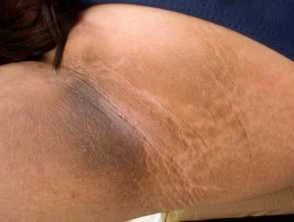
Acanthosis Nigricans
What is acanthosis nigricans?
Acanthosis nigricans is a skin condition characterized by dark, thickened, and often velvety patches of skin. These patches commonly appear in the armpits, groin, neck, elbows, knees, and knuckles. While not harmful on its own, acanthosis nigricans can be a sign of an underlying health issue.
What causes acanthosis nigricans?
The precise cause of acanthosis nigricans isn't always clear, but several factors and conditions are associated with its development:
Insulin resistance: About 50% of individuals with acanthosis nigricans have insulin resistance, where the body can't use insulin efficiently. This leads to elevated insulin levels, potentially causing skin cells to proliferate abnormally.
Hormonal disorders: Conditions like polycystic ovary syndrome, Cushing's syndrome, and adrenal gland disorders can be associated with acanthosis nigricans.
Medications: Some drugs, including niacin, oral contraceptives, and corticosteroids, can trigger the condition.
Cancer: On rare occasions, acanthosis nigricans has been linked to gastrointestinal adenocarcinomas and other internal malignancies.
Genetic factors: Some people inherit a predisposition to develop acanthosis nigricans.
What are the symptoms of acanthosis nigricans?
The primary symptom is the presence of dark, thickened patches of skin that feel velvety. These patches may also itch or have an odor. Over time, the affected areas of skin may become rough.
How do I treat acanthosis nigricans?
Treating the underlying cause, when identified, can improve the skin's appearance:
Insulin resistance management: Addressing the root causes of insulin resistance, such as obesity, can reduce symptoms.
Medication change: If a specific drug is suspected as the cause, switching to a different medication might help.
Topical treatments: Dermatologists might recommend prescription creams or lotions to lighten the affected areas.
Oral medications: In some instances, oral medications, such as isotretinoin, can be beneficial.
Procedures: Techniques like laser therapy, dermabrasion, or chemical peels can be employed to diminish the skin's thickness.
How do I prevent acanthosis nigricans?
Prevention strategies are primarily focused on managing risk factors:
Maintain a healthy weight: Achieving and maintaining a healthy weight can reduce the risk of insulin resistance.
Regular check-ups: Regular medical check-ups can help detect potential hormonal imbalances or insulin resistance early on.
Medication review: If you're on medications known to cause acanthosis nigricans, regular reviews with your healthcare provider can help assess the necessity of those drugs.
An example of how acanthosis nigricans can appear on the armpit
Credit: DermNet NZ
On the elbow, acanthosis nigricans can appear dry and rough
Credit: DermNet NZ



